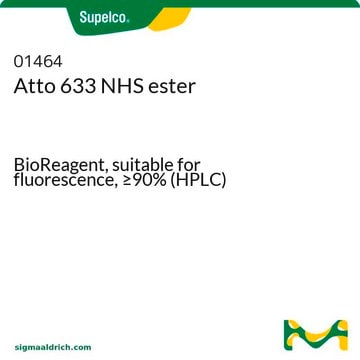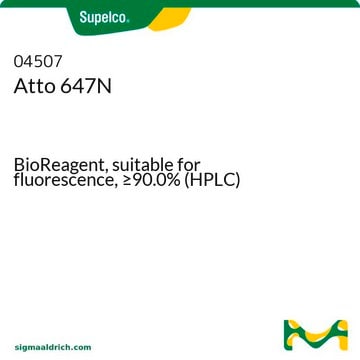Recommended Products
product line
BioReagent
Assay
≥90.0% (HPLC)
form
solid
manufacturer/tradename
ATTO-TEC GmbH
λ
in ethanol (with 0,1% trifluoroacetic acid)
UV absorption
λ: 627-633 nm Amax
suitability
suitable for fluorescence
storage temp.
−20°C
Application
Atto 633 is a red-emitting fluorescence label with strong absorption, high quantum yield (64%), high photostability, good water solubility, and very little triplet formation. This label is optimized for use with diode laser excitation at 633 nm and characterized by high photostability.
Legal Information
This product is for Research use only. In case of intended commercialization, please contact the IP-holder (ATTO-TEC GmbH, Germany) for licensing.
Storage Class Code
11 - Combustible Solids
WGK
WGK 3
Flash Point(F)
Not applicable
Flash Point(C)
Not applicable
Personal Protective Equipment
dust mask type N95 (US), Eyeshields, Gloves
Certificates of Analysis (COA)
Search for Certificates of Analysis (COA) by entering the products Lot/Batch Number. Lot and Batch Numbers can be found on a product’s label following the words ‘Lot’ or ‘Batch’.
Already Own This Product?
Find documentation for the products that you have recently purchased in the Document Library.
Customers Also Viewed
Sotirios S Tragoulias et al.
Analytical and bioanalytical chemistry, 390(6), 1563-1573 (2008-01-30)
Microarray technology covers the urgent need to exploit the accumulated genetic information from large-scale sequencing projects and facilitate investigations on a genome-wide scale. Although most applications focus on DNA microarrays, the technology has expanded to microarrays of proteins, peptides, carbohydrates
Martin Beutler et al.
European biophysics journal : EBJ, 38(1), 69-82 (2008-09-05)
We demonstrate theoretically and experimentally the quantification of Förster resonance energy transfer (FRET) by direct and systematic saturation of the excited state of acceptor molecules. This version of acceptor depletion methods for FRET estimation, denoted as "satFRET" is reversible and
Maria Strianese et al.
Protein and peptide letters, 18(3), 282-286 (2010-09-23)
A new, fast, simple and cost-effective sensing device for monitoring H(2)S has been developed. Proof-of-principle results showing that a commercial and cheap Myoglobin (Mb) can be successfully used as a biological probe for a fluorescence biosensor for H(2)S detection are
Thomas D Lazzara et al.
Journal of colloid and interface science, 366(1), 57-63 (2011-10-29)
Anodic aluminum oxide (AAO) substrates with aligned, cylindrical, non-intersecting pores with diameters of 75 nm and depths of 3.5 or 10 μm were functionalized with lipid monolayers harboring different receptor lipids. AAO was first functionalized with dodecyl-trichlorosilane, followed by fusion
Ronny Schmidt et al.
Journal of proteome research, 10(3), 1316-1322 (2011-01-21)
Based on a single-molecule sensitive fluorescence-linked immunosorbent assay, an analytical platform for the detection of lipoarabinomannan (LAM), a lipopolysaccharide marker of tuberculosis, was established that is about 3 orders of magnitude more sensitive than comparable current ELISA assays. No amplification
Our team of scientists has experience in all areas of research including Life Science, Material Science, Chemical Synthesis, Chromatography, Analytical and many others.
Contact Technical Service





